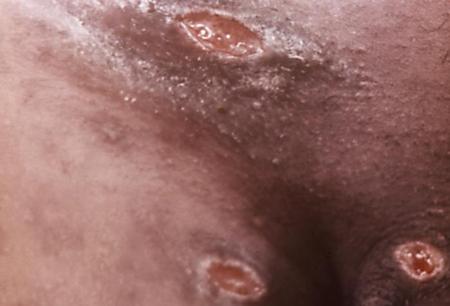Summary
Definition
History and exam
Key diagnostic factors
- presença de fatores de risco
- úlceras genitais
- linfadenite inguinal e bubões
- pápulas genitais
Other diagnostic factors
- disúria
- corrimento vaginal
- dispareunia
- dor ou sangramento retal
- fístula retovaginal
- fístula uretral
- úlceras extragenitais
Risk factors
- vários parceiros sexuais
- contato sexual com profissional do sexo
- relação sexual sem proteção
- abuso de substâncias
- sexo masculino
- ausência de circuncisão
- falta de higiene pessoal
- portador assintomático
Diagnostic investigations
1st investigations to order
- cultura de swabs da úlcera
- reação em cadeia da polimerase para Haemophilus ducreyi
- Coloração de Gram de swabs de úlcera
- teste de sífilis
- Reação em cadeia da polimerase para vírus do herpes simples (HSV) e culturas virais
- teste de HIV
Investigations to consider
- sorologia do Haemophilus ducreyi
- Sensibilidade antimicrobiana do Haemophilus ducreyi
- biópsia da úlcera
Emerging tests
- imunofluorescência: teste de antígeno de Haemophilus ducreyi direto ou indireto
Treatment algorithm
cancroide genital: HIV-negativo
cancroide genital: HIV-positivo
sem resposta ao tratamento inicial
Contributors
Authors
Professor Michael Marks, MRCP, DTM&H, PhD
Honorary Consultant in Infectious Diseases
Faculty of Infectious and Tropical Diseases
London School of Hygiene & Tropical Medicine
Hospital for Tropical Diseases
University College London
London
UK
Disclosures
MM declares that he has no competing interests.
Acknowledgements
Professor Michael Marks would like to gratefully acknowledge Dr Tara Babu, Dr Marguerite A. Urban, and Dr Christina Bailey, previous contributors to this topic.
Disclosures
TB, MAU, and CB declare that they have no competing interests.
Peer reviewers
Eva Jungmann, FRCP, MSc
Consultant Physician
GUM/HIV Camden Primary Care Trust
Archway Sexual Health Clinic
London
UK
Disclosures
EJ declares that she has no competing interests.
Diane M. Janowicz, MD
Assistant Research Professor in Medicine
Indiana University Department of Medicine
School of Medicine
Indianapolis
IN
Disclosures
DMJ declares that she has no competing interests.
Peer reviewer acknowledgements
BMJ Best Practice topics are updated on a rolling basis in line with developments in evidence and guidance. The peer reviewers listed here have reviewed the content at least once during the history of the topic.
Disclosures
Peer reviewer affiliations and disclosures pertain to the time of the review.
References
Key articles
Workowski KA, Bachmann LH, Chan PA, et al. Sexually transmitted infections treatment guidelines, 2021. MMWR Recomm Rep. 2021 Jul 23;70(4):1-187.Full text Abstract
Reference articles
A full list of sources referenced in this topic is available to users with access to all of BMJ Best Practice.

Differentials
- Infecção por sífilis
- Infecção por vírus do herpes simples (HSV)
- Linfogranuloma venéreo
More DifferentialsGuidelines
- Reducing sexually transmitted infections
- Sexually transmitted infections treatment guidelines, 2021
More GuidelinesPatient information
Clamídia
Herpes genital
More Patient informationLog in or subscribe to access all of BMJ Best Practice
Use of this content is subject to our disclaimer